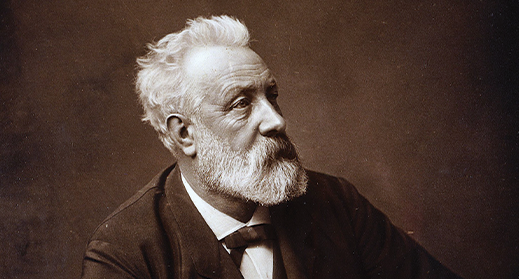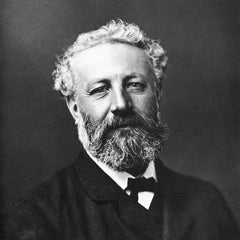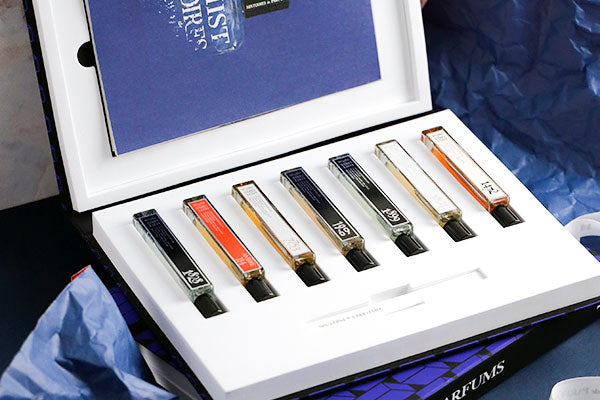
1828 - Jules Verne

Dubbed the literary father of science fiction, Jules Verne was born on February 8, 1828 in Nantes, France. It was there in Nantes, a port city, that Jules first became fascinated with travel, adventure, and exploration on the sea, urgently seeking whatever was just beyond the horizon. With an exciting Hesperide sparkle, 1828 echoes Verne’s aquatic adventures with spices from faraway lands and the precious woods of stories on your night table.
The eldest of five brothers, Jules’ education was decided upon by the family patriarch, Pierre Verne, as a career in law. Jules acquiesced to his father’s wishes, studying law in Nantes and Paris in his late teens, the late 1840s.
But in Paris, everything would change for Verne. After rubbing elbows with Alexandre Dumas and Dumas’ son in literary social circles, the Dumas men would aid Verne in realizing his first play: The Broken Straws, a great success. By 1852, fully entrenched in art, literature, and theater in Paris, Verne declined his father’s job offer to be an attorney. Instead, Verne was appointed secretary of the Lyrical Theater, enchanting his creative passions.
In 1856 Verne met his wife, Honorie Meurel, a young widower with children. Together, they had a child, Michel Verne. It was not too soon after that the publisher Hetzel would also enter Verne’s life. Verne submitted his first manuscript to Hetzel, Five Weeks in a Balloon (1863) — the first entry of 54 in Extraordinary Voyages. This was the beginning of a 72-book literary career, nearly one well-researched science fiction novel for every year of Verne’s 77-year life. The expansive volume of writing did not dilute his quality; in fact it made him iconic. No doubt you’ve heard of Journey to the Center of the Earth (1864), or From the Earth to the Moon (1865). Verne was scientifically prudent in his writing, solving for the effects of space travel on the human body, and even estimating that rockets would launch from the Floridian coast, exactly where they are launched today.
It was only in 1867 that Verne began to traverse the seas, sailing first to America, to New York City and Niagara Falls. Verne’s captivation with the sea—the mysteries below, and the horizons ahead—inspired him to eventually buy his own boat, named Saint Michel. With this boat, Verne began travelling all along the Mediterranean, visiting Scotland and Norway, and then heading on even longer voyages, continuously seeking inspiration and clarity from the deep blue sea.
In 20,000 Leagues Under the Sea (1869), Verne unequivocally placed science fiction as the bridge between the classics of old and the inventions of the future. Captain Nemo’s name is a reference to The Odyssey; the concept of a submarine would go on to become reality.
In Around the World in 80 Days (1872), Verne elegantly reflected the innovation of global travel while he materialized/invented a world made even smaller with Phileas Fogg’s record-breaking, dizzying trip around the world. He fomented competitions between ambitious mariners emulating Fogg for decades. Inspired by an imagination as vast as the sea, but grounded in science, Verne would shape the world for centuries to come. The genre of science fiction, the submarine, the helicopter, video conferencing, holograms, solar sails, lunar modules… all tumbling through Verne’s mind and stories before they were even made reality.
For Verne, scientific innovation wasn’t a simple, glorified horizon. He was critical of the very science he was fascinated by, which is why he wrote about the dangers of species extinction, and the destruction of the environment over oil—concepts that some even grapple with today. Verne’s last book, Paris in the Twentieth Century, was published in 1994, 131 years after it was written, in 1863. It was deemed too radical for the time—a dystopian critique of technology, society, and science. Why was it published so long after it was written? Well, most of what Verne wrote about turned out to be true…
Jules Verne died due to complications with diabetes on March 24, 1905 in Amiens. His body is buried at the Madeleine cemetery in a funeral attended by over 5,000. On his tombstone is the epitaph “Towards immortality and eternal youth,” with a sculpture of a man defying gravity: pulling himself up and towards the heavens.
New technologies brought on by industrialization presented Verne with possibilities previously unimagined. They inspired a life of voyages and extraordinary stories of science, puzzles, journeys, and monsters. His own charisma forever ingrained in unforgettable characters such as the famous Phileas Fogg or the formidable Captain Nemo. Carving out the genre of Science Fiction with some of the world’s most iconic and forward-thinking literary publications, Verne is the second most translated author following Agatha Christie and followed by William Shakespeare.
1828 is the scent of Jules Verne, of a treasure chest of precious Wooden adventures filled with exotic Spices from faraway lands stowed on a boat sailing uncharted seas. At its core lies innovation of the unknown, vetiver spindles intertwine with ascending tendrils of incense smoke—a momentary catch and then release—alongside planks of coarse-grained Cedarwood dappled with small, resinous Pine cones. The aromas of fiery Indonesian Nutmeg grounds and Black Peppercorns are carried in wafts of sea breeze, expanding in the heart of the ship, between wood and sea—a sea of velour-like Eucalyptus enveloping the acute citric refreshment of Grapefruit and Tangerine. A scent with the same crushing magnetism of the ocean’s waves, frothy white foam that slowly dissolves into inky azurite waters, waves that will carry you to horizons unknown.





